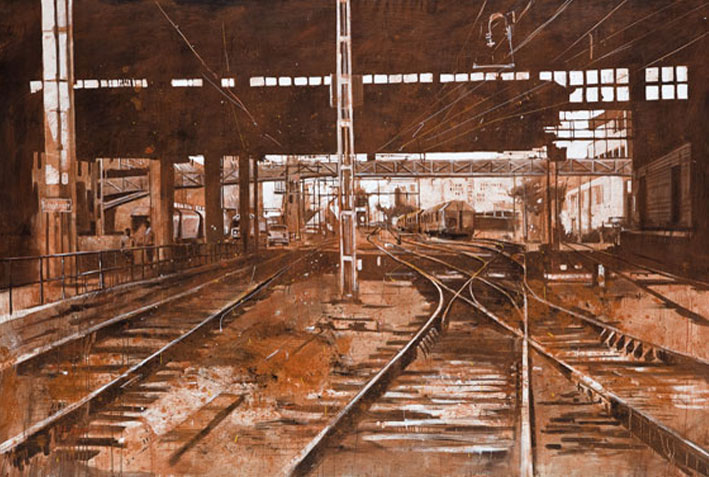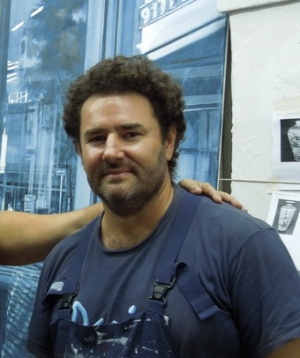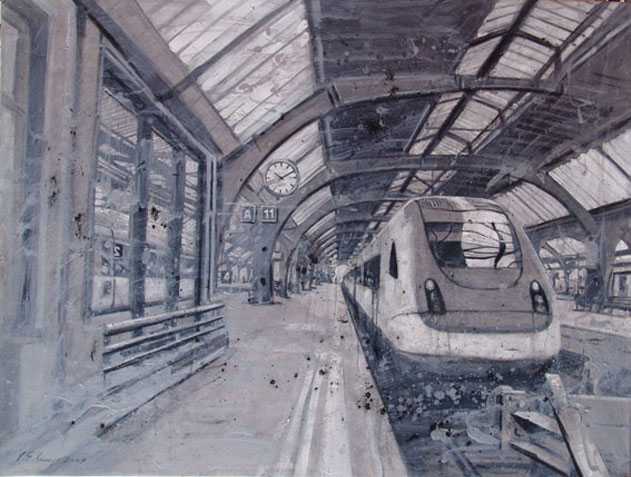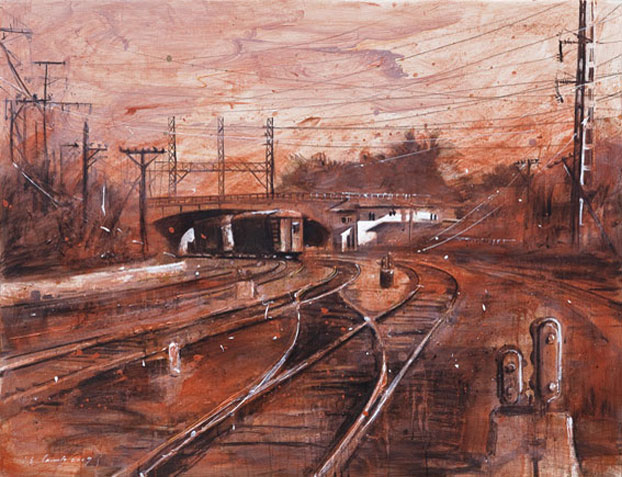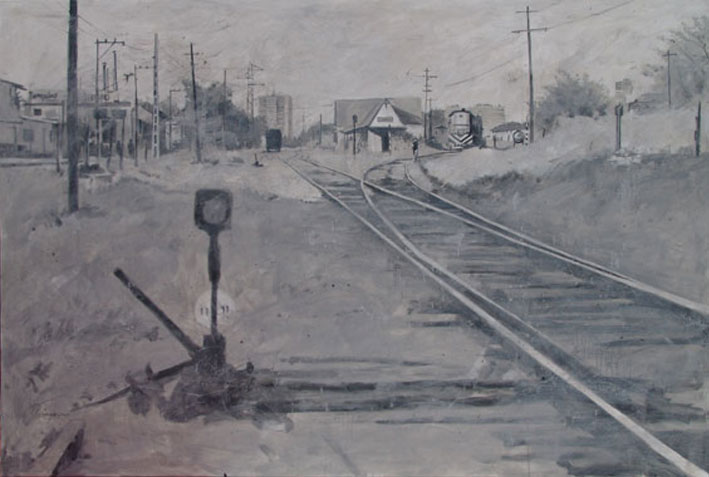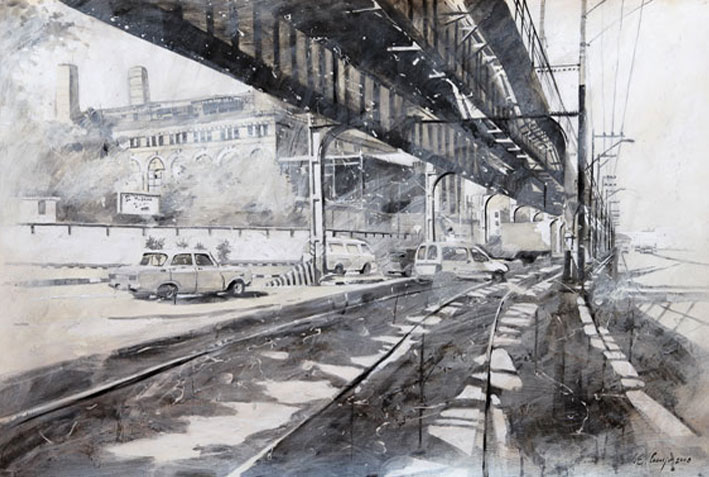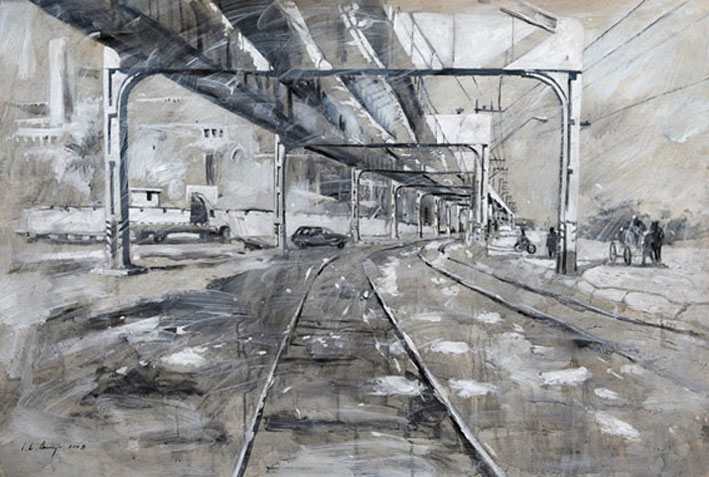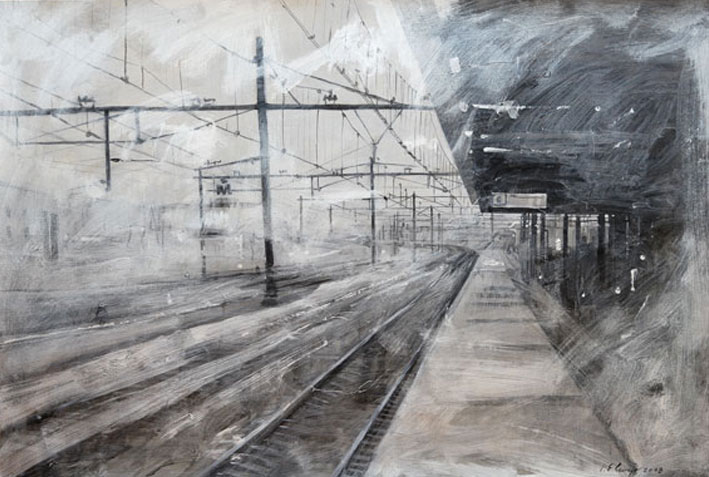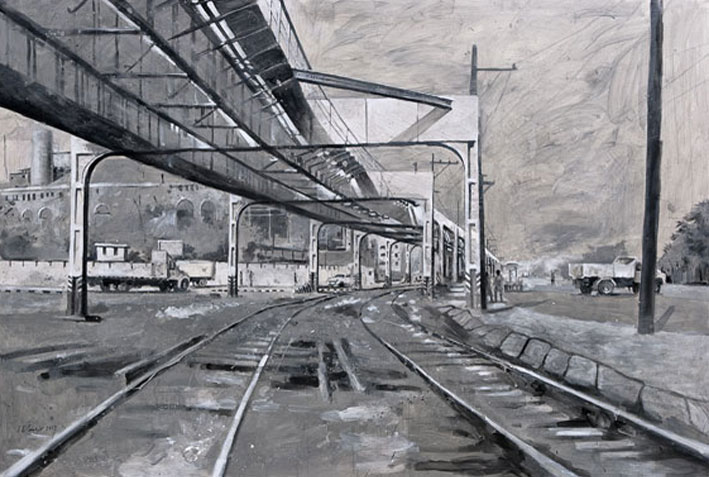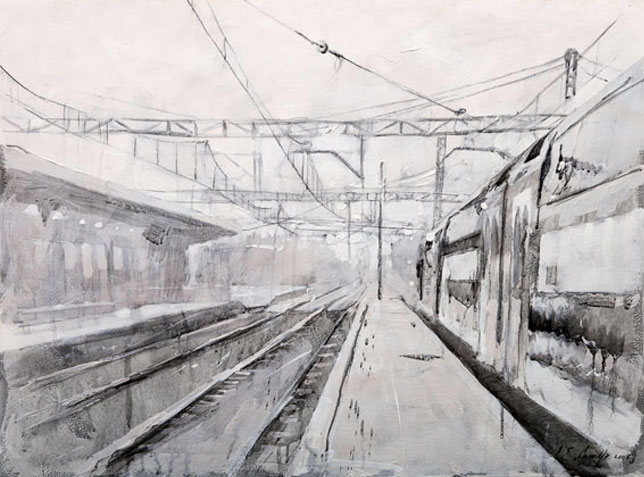Stations
Camejo and the Deconstruction of the Environment
The work by Luis Enrique Camejo confirms all the time the vulnerability of the absolutes, subverts the rigid delimitations with which some theorists have tried to avoid the complex evolution of the link between tradition and contemporariness, between aesthetic joy and intellectual conscience. His painting should not only be valuated as an innovative experience induced toward such an ancient form as the landscape, but also as a keen action of resetting into context, displayed with the purpose of expanding the means and cunning of conceptual art.
Camejo has not been the sole Cuban artist interested in facing this diversification alternative through the symbolical manipulation of the urban environment. During the instrumental and allegorical changes occurred in the early nineties long before he became known and reached an accredited space urban landscapes already appeared as adequate alternatives for the tropological re-evaluation in painting and photography. The same thing occurred with rural landscapes, although in this regard the readapting processes very soon incorporated rhetorical, conciliatory formulas as a result of the interaction of their exponents with the art market a market that more willing to comply with their nineteenth-century tastes than to support certain values and establish them.
The differences in the introduction of both trends became so great that at this height urban landscapes enjoy greater credibility with respect to rural ones concerning the capacity of expressive and metaphorical readapting. Although we must recognize that the recreation of urban environmentsparticularly through abstract painting, now in open revitalizationhas granted too much priority to the simulation of destructed, marginal and even scatological contexts as a recurrent, stale form of privileging the relation between individual and circumstance.
What is peculiar, however, in the work by Luis Enrique Camejo is that, without disbelieving codes and nuances subordinated to certain cultures and social contexts, he has succeeded in raising the allegorical dimension of his landscapes to a more ecumenical level an ecumenicism that is essentially sustained on the point of view of an artist who evades the dogmatic reproduction of the autochthonous, of a sensibility that is willing to experiment, more than regional differences, the possible mental, spiritual analogies that may coexist in the global present environments. With that purpose he has succeeded in escaping the geographical and political conditionings and in turning the perceptive, representational experience into a liberating and at the same time integrationist exercise.
If we draw a balance of the purposes that have historically encouraged the practice of landscape painting in the Island, we will verify that Camejo’s painting inserts itself into that evolutional process and even renews it. For example, the first purpose of foundational nature in the Cuban art landscape was the one through which we attempted to reveal with our own eyes or foreign ones the urban or rural form of the Island, without any concern for the canonic influence of the West; the second one revealed the attempt to overcome the technical and aesthetic imitation while we offered a more genuine and modern impression of our geographical and social composition. The third one reveals us now adding the value of the metaphorical, of the discursive, to the representational nature of the vernacular or autochthonous.
Camejo’s conceptual landscapes insert themselves in that last tropological form that began to take shape toward the end of the decade of the eighties, but his pieces do not emphasize on the identifying characteristics of a specific context, nor do they seek to shelter their meanings in the inequality or exclusion, but in the similarities, in the processed equivalences based on the subjectivity a subjectivity that is not only indebted with the Cuban-ness, the insularity, but also with the world, with the generic condition of the civilized individual. I even believe that, in order to understand the conceptual and aesthetic intentions of his landscapes, we would have to take into consideration that Camejo comes from a generation that is immerse in new experiences of artistic and human interaction at international scale, that he belongs to a promotion of artists to whom access to cultural diversity is no longer an impossible notion.
To honor the truth, the road abroad was already traced when he and his fellow countrymen emerged in the public scene. They did not have to experience the upheavals or the exclusions of other promotions of artists. They assumed the journey as a natural option, a necessary one, without letting themselves be influenced by doubt, without even thinking of the option of no return, and they opened a succession of comings and goings that was unprecedented in the Cuban socio-cultural project. To these creators, the cities of America, Europe or Asia have not been as they were to many in the decade of the seventies and part of the eighties illusory decorations, vague impressions of stories, gifts granted by some institution or ministry, but scenes at hand’s reach, communities, people with whom one could interact from nearby and compare. Many times I have asked myself: which would have been the fate of those artists who migrated in the late eighties if they had been free to move in the same way that at least a good many artists move today? Would the distances and prejudices expressed today by certain artists established abroad toward the Island’s intellectual context have been so radical?
For years we have witnessed a circumstance of self-determination that has been influencing the openings of approach and art appreciation, as in the case of the work by Enrique Camejo. The question is not to keep on contemplating ourselves with restlessness or resignation, or to keep on examining the outer world with a conceited or sectarian logic, but to examine the modern world starting from a dialogic relationship to it; of attempting to create a system of visual analogies whose sole mediators are feelings and the spirit.
Situations or sensations like serenity, indifference, anxiety, loneliness or nostalgia seem to be reasons of homologation among the environments recreated by Camejo. No matter whether we are in front of a coast, a series of shop windows, a bus stop, a centric avenue in Havana, Panama or Spain. The atypical elements of architectonic and urban tracing, the aspects related with the passing of time gradually dilute into the visual insinuations created by the mental situations that the art subject is going through when he plunges into those environments.
Some might think that it is the technical sufficiency what moves the compositional logic of his pictures that the artist attempts to exalt the imitational tricks of his drawing, surprise us with his unique combinations of forms and shades. A fitting supposition for those who today have an excessive appreciation of the craft and its gimmick. And it may be that they are partially right, because Camejo’s landscapes have an unequal method to summarize both line and color, to conceive the grading of lights, planes and outlooks. His stroke is lose, natural, precise; it stands out from the excessive detail, from the eclecticism of Cuban landscape artists; it is exhibited as unimpeachable evidence of the tricks we might introduce in order not to keep on copying, but rather to suggest, to make as the saying goes more with less.
He is, in addition, outstanding in the simulation of contexts through the exclusive use of grays and blacks, a quality we had not seen displayed with such naturalness since those huge paintings by Gustavo Acosta from the eighties. In short, everything is technically pertinent in Camejo’s landscapes to create scenes that occur as illusions in the morning, at sunset or at night, spaces in which the inclemency of the weather disturbs the visibility of the view, or in which the rain blurs the outlines, the figures of passers-by and vehicles, as if we observed reality through a tarnished glass. However, when we realize that the situation and sensations of the environment are repeated over and over again in an obsessive way, as if we looked through the same prism, that it is they that create the main effects and the suggestive nature of the view, we become aware than such technical presumptions move to a second plane; that the privileged effect is an exercise of personal association, a subtle move, at times ludicrous, of perceptive scrutinizing that suggests canons or guidelines in an inverse direction to the usual one in the genre, that is to say, from inside toward outside, from the intimate situation of the creator to the surrounding reality.
It is not about beauty, about seduction or amazement that the small and medium format landscapes created by Camejo tell us about. They even reflect a moderation, a compositional rationality that is typical of a traveler, of a chronicler who does not seem to be easily moved by what is different and unusual. Camejo’s landscapes speak of himself, of the craftsman, of his searches and concepts about the cities he visits, feels, breathes; of how he has been capable of discovering feelings and atmospheres that are absolutely compatible in different human conglomerates; of how many of those feelings may become perpetual in spite of the change of contexts, stage designs, and determine for a long time our way of contemplating reality and interacting with it.
It even occurs to me that Camejo’s landscapes close a cycle in the redefinition of the maps of identity and life induced during the past couple of decades by Cuban art. Among the paradigmatic creators of this trend, I think the most outstanding are Antonio Eligio (Tonel) and Ibrahim Miranda. Tonel questions with enormous sarcasm our idyllic ordering of the civilized universe; he opposes our pretensions of models (let us think, for example, of the piece Dreamed World, which is exhibited in the permanent collection of the National Museum of Fine Arts). Ibrahim ironically reconstructs the conventional cartographies imposed by history and assumed mimetically by our societies (any one of his works included in the series Urban Islands could be an archetype of this assertion). Camejo deconstructs, re-draws the inhabitable spaces and dismounts the interiorities and living dynamics of the environments. Together with Tonel and Ibrahim Miranda, he would form something like a triad that explores the landscape from the genetic to the individual, from the perceptual to the contingent.
David Mateo
Havana, July 29, 2009
Artists
